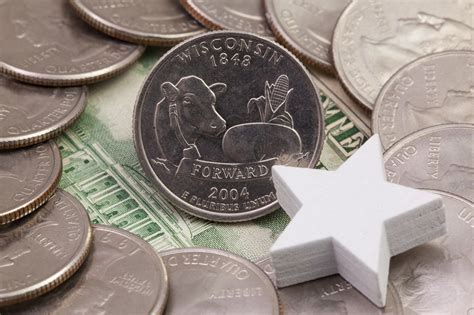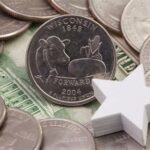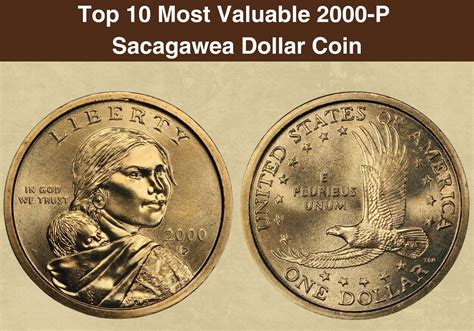
A potential windfall may be lurking in your spare change: certain 2004 state quarter errors could fetch collectors up to $2,000. Coin collectors are actively seeking specific variations, particularly those with visible errors in the design or minting process.
A close look at your collection of 2004 state quarters could turn up a valuable error coin, primarily related to the Wisconsin State Quarter. The 2004-D Wisconsin State Quarter, specifically those minted in Denver, are highly sought after due to notable minting errors. The most famous of these errors are the “extra leaf high” and “extra leaf low” varieties. These errors occurred when the die used to strike the coins was inadvertently altered, resulting in the appearance of an extra leaf on the corn stalk depicted on the reverse side of the coin.
These errors are easily identifiable by examining the corn stalk on the reverse of the coin, specifically the leaves extending from the bottom left of the stalk. The “extra leaf high” variety shows an extra leaf prominently extending upward, while the “extra leaf low” shows the additional leaf closer to the bottom.
While not all 2004 state quarters are valuable, these specific error coins are worth significantly more than their face value. The value of these coins depends on their condition, rarity, and the demand among collectors. Uncirculated or near-mint condition coins command the highest prices.
According to numismatic experts, the value of a 2004-D Wisconsin State Quarter with the “extra leaf” error can range from a few hundred dollars to as much as $2,000 or more for exceptionally well-preserved examples. The “extra leaf high” variety tends to be more valuable than the “extra leaf low” due to its perceived rarity.
The United States Mint produces billions of coins each year, and errors, while rare, do occur. These errors can range from minor imperfections to significant design flaws, and they often become highly sought after by collectors. The allure of error coins lies in their uniqueness and the stories they tell about the minting process.
The 2004 Wisconsin State Quarter was part of the 50 State Quarters Program, a highly successful initiative by the U.S. Mint that ran from 1999 to 2008. The program featured unique designs for each state on the reverse side of the quarter, celebrating the history, geography, and culture of the United States. The Wisconsin quarter, designed by Alfred Maletsky, depicts a cow, a wheel of cheese, and an ear of corn, representing the state’s strong agricultural heritage.
The errors on the 2004 Wisconsin State Quarter quickly gained attention among coin collectors, leading to a surge in demand and a corresponding increase in value. The online marketplace has played a significant role in facilitating the buying and selling of these error coins, with platforms like eBay and specialized coin auction sites serving as popular venues.
Numismatists advise carefully examining any 2004 Wisconsin State Quarters for the telltale “extra leaf” before spending them. A magnifying glass can be helpful in identifying the subtle details of the error. If you suspect you have found a valuable error coin, it is recommended to consult with a professional coin appraiser or a reputable coin dealer for an accurate assessment of its value.
Even if you don’t find a valuable error coin, collecting state quarters can be a rewarding hobby. The 50 State Quarters Program sparked widespread interest in coin collecting, and many people continue to enjoy searching for and collecting these coins. The program also served as an educational tool, teaching Americans about the history and culture of each state.
The potential to find a valuable error coin adds an element of excitement to the hobby of coin collecting. While the odds of finding a rare and valuable coin may be slim, the possibility is always there, making it a fun and engaging pursuit for many.
The Wisconsin Quarter error isn’t the only error that has driven up the value of coins. A 1969-S Doubled Die Lincoln Cent can be worth tens of thousands of dollars, and even some modern coins with minor errors can fetch a premium. This is part of what makes coin collecting so popular, the chance to find an item that is not only old but is now worth much more than its initial face value. The key to finding these valuable errors is education, knowing what to look for, and having a keen eye for detail.
The process for identifying valuable coins often starts with understanding the specific features of the coin in question, how the minting process works, and common types of errors. Coin collecting is a hobby that requires patience, persistence, and a willingness to learn. Numerous resources are available to help collectors, including books, websites, and coin collecting clubs. These resources provide valuable information on coin grading, authentication, and valuation.
The 2004 Wisconsin State Quarter error serves as a reminder that valuable treasures can sometimes be found in the most unexpected places. So, take a closer look at your spare change – you might just be surprised at what you find. The thrill of the hunt is a big part of collecting and many individuals dedicate a lot of their free time to this hunt.
Coin collecting and numismatics have a long and rich history, dating back centuries. Coins have always been more than just a medium of exchange; they are also historical artifacts that provide insights into the economies, politics, and cultures of past civilizations. The study of coins can reveal a wealth of information about the history of a region, the rulers who governed it, and the artistic styles that were prevalent at the time.
The 50 State Quarters Program created a new generation of collectors, exposing younger generations to the hobby. This revitalized interest in coins and coin collecting, contributing to an overall increased appreciation for the historical and cultural significance of coinage. The program’s success demonstrates the enduring appeal of coin collecting and its ability to connect people with the past.
In addition to the Wisconsin Quarter, other state quarters have also been found with errors, although none have achieved the same level of notoriety or value. These errors typically involve minor design flaws, such as doubled dies, off-center strikes, or missing elements. While these errors may not be as valuable as the Wisconsin Quarter error, they can still be worth a premium to collectors.
The value of a coin is determined by several factors, including its rarity, condition, and demand. Rarity refers to the number of coins that were originally minted and the number that still exist today. Condition refers to the physical state of the coin, with uncirculated or near-mint condition coins being the most valuable. Demand refers to the number of collectors who are actively seeking to acquire the coin.
Coin grading is a standardized system used to assess the condition of a coin. The most widely used grading system is the Sheldon Scale, which assigns a numerical grade to each coin ranging from 1 (Poor) to 70 (Perfect Mint State). The higher the grade, the more valuable the coin.
Authentication is the process of verifying the authenticity of a coin. Counterfeit coins are a significant problem in the numismatic world, and collectors must be vigilant in ensuring that the coins they are acquiring are genuine. There are several methods for authenticating coins, including visual inspection, weight and measurement analysis, and professional certification.
The internet has revolutionized the coin collecting hobby, providing collectors with access to a wealth of information and resources. Online forums, websites, and auction sites have made it easier than ever to buy, sell, and trade coins. The internet has also facilitated the development of online communities of collectors, where enthusiasts can share their knowledge, ask questions, and connect with others who share their passion for numismatics.
The value of error coins can fluctuate over time, depending on market conditions and collector demand. It is important to stay informed about the latest trends in the numismatic market and to consult with a professional coin appraiser before buying or selling any valuable coins.
The 2004 Wisconsin State Quarter error is a fascinating example of how a seemingly insignificant imperfection can transform a common coin into a valuable collectible. It is a testament to the enduring appeal of coin collecting and the thrill of the hunt for rare and valuable treasures. The story of the Wisconsin Quarter error has captured the imagination of collectors and non-collectors alike, and it serves as a reminder that valuable discoveries can sometimes be found in the most unexpected places. So, the next time you find yourself with a handful of spare change, take a closer look – you might just be holding a hidden treasure.
The United States Mint’s facilities are located in Philadelphia, Denver, San Francisco, and West Point. Each facility produces different types of coins, and each mint mark helps to identify where the coin originated. The Denver Mint is identified by the letter “D” on the coin. Error coins can originate from any of these facilities, but it is the 2004-D Wisconsin State Quarter where the errors have created such high value.
In the world of numismatics, understanding the nuances of minting errors is critical for collectors. These errors can occur at various stages of the coin production process, including die preparation, striking, and finishing. A doubled die error happens when the die used to strike the coin has been improperly created, resulting in a doubled or distorted image. An off-center strike occurs when the coin is not properly aligned within the striking chamber, resulting in an image that is not centered on the coin. A clipped planchet error occurs when the metal blank (planchet) from which the coin is struck is missing a portion of its edge.
The value of a coin is not solely determined by its rarity or condition; it is also influenced by its historical significance and its aesthetic appeal. Some coins are valued for their historical association with important events or figures. Others are valued for their artistic design and their beauty.
The rarity of the 2004 Wisconsin State Quarter error coins is due to the fact that the error was only present on a limited number of coins. The exact number of error coins that were produced is unknown, but it is estimated to be relatively small compared to the total number of 2004 Wisconsin State Quarters that were minted. This scarcity, combined with the high demand from collectors, has driven up the value of these error coins.
Coin collecting can be a solitary hobby, but it can also be a social activity. Many collectors join coin clubs and attend coin shows, where they can meet other collectors, share their knowledge, and buy, sell, and trade coins. These events provide a valuable opportunity for collectors to learn from each other and to expand their collections.
The 50 State Quarters Program was a significant success for the U.S. Mint, generating billions of dollars in revenue and sparking renewed interest in coin collecting. The program demonstrated the power of coinage to promote education, celebrate American history and culture, and engage the public in a meaningful way.
The study of numismatics can provide valuable insights into the past, helping us to understand the economic, political, and social forces that have shaped our world. Coins are not just pieces of metal; they are historical artifacts that tell stories about the people who created them and the civilizations that used them.
Collecting error coins can be a challenging but rewarding pursuit. It requires patience, persistence, and a keen eye for detail. But for those who are willing to put in the effort, the rewards can be substantial. The thrill of finding a rare and valuable error coin is an experience that few collectors forget.
The 2004 Wisconsin State Quarter error is a reminder that valuable treasures can sometimes be found in the most unexpected places. It is a testament to the enduring appeal of coin collecting and the thrill of the hunt for rare and valuable discoveries.
Always make sure you consult with professional coin appraisers if you think you may have found a valuable coin. They can give you the most up-to-date information and assessment on the coin in question.
Frequently Asked Questions (FAQ)
1. What specific 2004 quarter should I be looking for?
The 2004-D Wisconsin State Quarter, minted in Denver, is the one to watch out for. Specifically, look for those with “extra leaf high” or “extra leaf low” errors on the corn stalk on the reverse side of the coin.
2. How can I identify the “extra leaf” error on the Wisconsin quarter?
Examine the corn stalk on the reverse of the coin, specifically the leaves extending from the bottom left. The “extra leaf high” variety shows an extra leaf prominently extending upward, while the “extra leaf low” shows the additional leaf closer to the bottom. A magnifying glass can be helpful.
3. How much is a 2004 Wisconsin quarter with the “extra leaf” error worth?
The value can range from a few hundred dollars to $2,000 or more, depending on the condition of the coin and the specific variety (“extra leaf high” generally being worth more). Consult a professional coin appraiser for an accurate assessment.
4. What is the 50 State Quarters Program?
It was a U.S. Mint initiative from 1999 to 2008 that featured unique designs for each state on the reverse side of the quarter, celebrating their history, geography, and culture. The Wisconsin quarter was part of this program.
5. Where can I get my quarter appraised if I think it has the error?
Consult with a professional coin appraiser or a reputable coin dealer for an accurate assessment of its value. They can help you determine its grade and authenticity.









